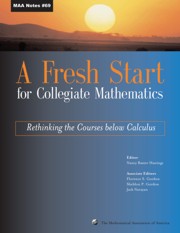Book contents
- Frontmatter
- Preface
- Contents
- Introduction
- Background
- Theme 1 New Visions for Introductory Collegiate Mathematics
- 7 Refocusing Precalculus: Challenges and Questions
- 8 Preparing Students for Calculus in the Twenty-First Century
- 9 Preparing for Calculus and Preparing for Life
- 10 College Algebra: A Course in Crisis
- 11 Changes in College Algebra
- 12 One Approach to Quantitative Literacy: Understanding our Quantitative World
- Theme 2 The Transition from High School to College
- Theme 3 The Needs of Other Disciplines
- Theme 4 Student Learning and Research
- Theme 5 Implementation
- Theme 6 Influencing the Mathematics Community
- Ideas and Projects that Work: Part 1
- Ideas and Projects that Work: Part 2
7 - Refocusing Precalculus: Challenges and Questions
from Theme 1 - New Visions for Introductory Collegiate Mathematics
- Frontmatter
- Preface
- Contents
- Introduction
- Background
- Theme 1 New Visions for Introductory Collegiate Mathematics
- 7 Refocusing Precalculus: Challenges and Questions
- 8 Preparing Students for Calculus in the Twenty-First Century
- 9 Preparing for Calculus and Preparing for Life
- 10 College Algebra: A Course in Crisis
- 11 Changes in College Algebra
- 12 One Approach to Quantitative Literacy: Understanding our Quantitative World
- Theme 2 The Transition from High School to College
- Theme 3 The Needs of Other Disciplines
- Theme 4 Student Learning and Research
- Theme 5 Implementation
- Theme 6 Influencing the Mathematics Community
- Ideas and Projects that Work: Part 1
- Ideas and Projects that Work: Part 2
Summary
Introduction
With this paper, I hope to initiate a dialogue about some of the challenges confronting refocusing precalculus. The paper articulates some of the forces for change in introductory mathematics courses at the collegiate level and how these concerns are being addressed. It describes the distinguishing features of alternative instructional materials and the pedagogical changes that the new materials have fostered in the teaching and learning environment. Many of these changes have been implemented in calculus; in fact, even the so-called traditional books reflect many of these new directions. Precalculus, however, lags behind.
What is the problem?
Introductory collegiate mathematics is in the midst of a revolution. Forces for change include:
a national concern about the lack of quantitative literacy among exiting college students [9, 11, 12, 13]
the need for improved education of prospective teachers to reflect the recommendations of the NCTM Standards and to allow prospective teachers to teach both the new subject matter and use the methods suggested [1, 8]
the recognition that many introductory mathematics courses have failed to be appealing or accessible to vast numbers of students entering colleges and universities—especially women and minorities
the concern that those teaching introductory mathematics do not take advantage of recent research findings in mathematics and science education [2, 3, 4, 6]
the concern that many courses do not make effective use of technology [7, 10, 14]
In addition, new fields of interest in mathematics and new mathematical techniques used in allied disciplines have led educators to examine the content of introductory mathematics courses [5].
- Type
- Chapter
- Information
- A Fresh Start for Collegiate MathematicsRethinking the Courses below Calculus, pp. 57 - 63Publisher: Mathematical Association of AmericaPrint publication year: 2006

